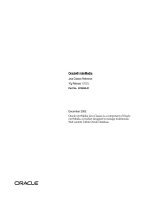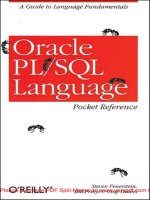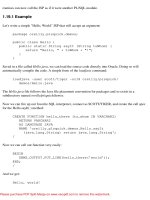Tài liệu Oracle PL/SQL For Dummies P2 pdf
Bạn đang xem bản rút gọn của tài liệu. Xem và tải ngay bản đầy đủ của tài liệu tại đây (460.3 KB, 20 trang )
Table 1-5 A Sample Relational PURCH_ORDER_DTL Table
PO_Nbr Line_Nbr Item Qty Price
450 1 Hammer 1 $10.00
451 1 Screwdriver 1 $8.00
451 2 Pliers 2 $6.50
451 3 Wrench 1 $7.00
452 1 Wrench 3 $7.00
452 2 Hammer 1 $10.00
453 1 Pliers 1 $6.50
A purchase order can include many items. Table 1-5 shows that Purchase
Order 451 includes three separate items. The link (foreign key) between the
tables is the Purchase Order Number.
Understanding basic database terminology
A database consists of tables and columns, as we describe in the preceding
section. There are some other terms you need to know in order to under-
stand how databases work. A database is built in two stages. First you create
a logical data model to lay out the design of the database and how the data
will be organized. Then you implement the database according to the physical
data model, which sets up the actual tables and columns. Different terminol-
ogy applies to the elements of the logical and physical designs. In addition,
relational database designers use different words from object-oriented (OO)
database designers to describe the database elements. Table 1-6 shows the
words used in each of these cases.
Table 1-6 Database Design Terminology
Logical/Relational Logical/Object-Oriented Physical Implementation
Entity Class Table
Attribute Attribute Column
Instance Object Row
12
Part I: Basic PL/SQL Concepts
05_599577 ch01.qxp 5/1/06 12:10 PM Page 12
The definitions of the words in Table 1-6 are as follows:
ߜ Entity: An entity corresponds to something in the real world that is of
interest and that you want to store information about. Examples of enti-
ties include things such as departments within an organization, employ-
ees, or sales. Each specific department or employee is considered an
instance of that entity. For example, in Table 1-3, Doug is an instance of
the entity Employee. (In the OO world, Doug would be an object in the
Employee class.)
ߜ Attribute: This word is used in both relational and OO databases to rep-
resent information about an entity instance or an object that will be
tracked. An example of an attribute might be the birth date or Social
Security number of an employee.
ߜ Entities (classes), their attributes, and instances (objects): These are
implemented in the database as tables, columns, and rows respectively.
One additional important concept to understand when dealing with relational
databases is the primary key. A primary key uniquely identifies a specific
instance of an entity. No two instances of an entity can have the same pri-
mary key. The values of all parts of the primary key must never be null. The
most common types of primary keys in relational databases are ID numbers.
For example, in Table 1-3, the EmpID can be the primary key. Sometimes more
than one attribute (or sets of attributes) can be used as a primary key. These
attributes are called candidate keys, one set of which must be designated as
the primary key.
Introducing database normalization
A database is considered normalized when it follows the rules of normaliza-
tion. Database normalization is useful for several reasons:
ߜ It helps to build a structure that is logical and easy to maintain.
ߜ Normalized databases are the industry standard. Other database profes-
sionals will find it easier to work with your database if it is normalized.
ߜ Retrieving data will be easier. This is actually the formal reason to nor-
malize. Graduate students in database theory courses often have to
prove a theorem that roughly states, “If your database is normalized,
you can be sure that any set of information you want to retrieve from
your database can be done by using SQL.”
You frequently need very complex procedural code to extract information
from a non-normalized database. The rules of normalization will help you to
design databases that are easy to build systems with.
13
Chapter 1: PL/SQL and Your Database
05_599577 ch01.qxp 5/1/06 12:10 PM Page 13
Although a detailed discussion of normalization is beyond the scope of this
book, there are three basic rules of normalization that every database profes-
sional should have memorized. Not so coincidentally, we tell you about them
in the following three sections.
First Normal Form (1NF)
First Normal Form means that the database doesn’t contain any repeating
attributes. Using the Purchase Order example from Tables 1-4 and 1-5, the
same data could be structured as shown in Table 1-7.
Table 1-7 PURCH_ORDER Table (1NF Violation)
PO_NBR DATE ITEM 1 QTY1 PRICE1 ITEM2 QTY2 PRICE2
450 12-10-06 Hammer 1 $10.00
451 02-26-06 Screwdriver 1 $8.00 Pliers 2 $6.50
452 03-17-06 Wrench 3 $7.00 Hammer 2 $10.00
453 06-05-06 Pliers 1 $6.50
Although this table looks okay, what if a third item were associated with PO
451? Using the structure shown in Table 1-7, you can order only two items.
The only way to order more than two items is to add additional columns, but
then to find out how many times an item was ordered, you’d need to look in
all the item columns. Table 1-7 violates First Normal Form.
You can build a good database that doesn’t adhere to First Normal Form by
using more complex collections such as VARRAYs and nested tables (which
we discuss in Chapter 11).
Second Normal Form (2NF)
Violations of Second Normal Form occur when the table contains attributes
that depend on a portion of the primary key.
To talk about Second Normal Form, you should know what we mean by an
attribute being dependent on another attribute. Say attribute X is dependent
upon attribute Y. Then if you know the value of attribute X, you have enough
information to find the value of attribute Y. Logically, attribute Y can have
only one value. For example, from the information in Table 1-1, if you know
the Employee Number (EmpNo), you also know the employee’s name, which
department number he or she works in, and the number of that department.
In this case, the EmpNo is the primary key. However, knowing the department
number and department name doesn’t tell you a specific employee’s name or
number. You can’t use the department number/name combination as the pri-
mary key. You can’t even use the name (Ename) as the primary key because a
large organization might have more than one “John Smith” working there.
14
Part I: Basic PL/SQL Concepts
05_599577 ch01.qxp 5/1/06 12:10 PM Page 14
Second Normal Form violations can exist only when you have a multi-column
primary key, such as the purchase order and the purchase order detail struc-
ture, as shown in Tables 1-8 and 1-9.
Table 1-8 PURCH_ORDER Table
PO_NBR DATE Vendor
450 12-10-06 ABC Co.
451 02-26-06 XYZ Inc.
452 03-17-06 XYZ Inc.
453 06-05-06 ABC Co.
Table 1-9 PURCH_ORDER_DETAIL Table (2NF Violation)
PO_NBR LINE DATE ITEM QTY PRICE
450 1 12-10-06 Hammer 1 $10.00
451 1 02-26-06 Screwdriver 1 $8.00
451 2 02-26-06 Pliers 2 $6.50
452 1 03-17-06 Wrench 3 $7.00
452 2 03-17-06 Hammer 2 $10.00
453 1 06-05-06 Pliers 1 $6.50
In this structure, the PURCH_ORDER_DETAIL table uses both PO_NBR and
LINE for the primary key. But DATE is dependent only on the PO_NBR (when
you know the PO_NBR, you know the date that each item was ordered), so
that column violates Second Normal Form.
Third Normal Form (3NF)
Third Normal Form violations occur when a transitive dependency exists. This
means that an attribute ID is dependent on another attribute that isn’t part
of either a primary or candidate key. These are serious violations indicating
errors in the database design that must be detected and corrected. Table 1-1
shows an example of Third Normal Form violation in a badly designed data-
base. The DeptName column is dependent only on the DeptNo column (that
is, if you know the department number, you know the name of the depart-
ment). The EmpNo is the obvious primary key, so the existence of DeptName
column violates Third Normal Form.
15
Chapter 1: PL/SQL and Your Database
05_599577 ch01.qxp 5/1/06 12:10 PM Page 15
All attributes in entities (columns in tables) must be dependent upon the pri-
mary key or one of the candidate keys and not on other attributes.
For more information about normalization, look at books about database
theory such as Beginning Database Design, by Gavin Powell (Wiley) and A
First Course in Database Systems, by Jeffrey D. Ullman and Jennifer Widom
(Prentice Hall), or numerous works by Chris J. Date.
What is a DBMS?
After you’ve designed a relational database, you need to implement it. The
easiest way to do this is by using a product that’s specifically designed for
this purpose. Products that perform these operations are called Relational
Database Management Systems (usually abbreviated to RDBMS or just DBMS).
They allow you to easily create relational databases by defining and creating
tables and then populating them with data. In addition, you could be provided
with a special tool to modify and manipulate the data and write reports and
applications to interact with the data.
DBMSs also handle all sorts of other important functions. They allow many
people to access the database at the same time without interfering with one
another or corrupting the data. They also make it easy to create backups in
case of problems such as a power failure or other disasters.
A number of positions in Information Technology involve interaction with a
DBMS:
ߜ Database designer: This person analyzes the requirements for the system
and designs an appropriate database structure to house the data.
ߜ Database administrator (DBA): This person installs the DBMS, monitors
it, and physically manages its operations.
ߜ Database application developer: This person writes the code that
resides within the DBMS and directly interacts with the database.
ߜ User interface (UI) application developer: This person writes the code for
the user interface, which enables users to communicate with the database.
Many other people, including project managers, software testers, and docu-
mentation specialists, also work with database systems. This book focuses
on the skills required to be a database application developer.
The Scoop on SQL and PL/SQL
As a database application developer, you interact with the Oracle DBMS
by using the programming languages Structured Query Language (SQL,
16
Part I: Basic PL/SQL Concepts
05_599577 ch01.qxp 5/1/06 12:10 PM Page 16
pronounced sequel) and Programming Language/Structured Query Language
(PL/SQL, pronounced either P-L-S-Q-L or P-L-sequel). In the following sections,
we introduce how SQL and PL/SQL work together and how they are different.
We also introduce what’s new in the current versions.
The purpose of SQL and PL/SQL
SQL is the industry standard language for manipulating DBMS objects. Using
SQL, you can create, modify, or delete database objects. This part of SQL is
called Data Definition Language (DDL). You can also use SQL to insert, update,
delete, or query data in these objects. This part of SQL is called Data
Manipulation Language (DML).
Oracle’s implementation of SQL isn’t exactly industry standard. Virtually
every DBMS (Oracle included) has invented items that are not part of the
standard specification. For example, Oracle includes sequences and support
for recursive queries that aren’t supported in other DBMS products.
17
Chapter 1: PL/SQL and Your Database
Oracle is more than a database
The Oracle environment doesn’t consist solely
of the DBMS. The Oracle environment itself is
enormous and complex, and the large number
of products that Oracle sells is a reflection of
that. So how does the DBMS fit into the bigger
picture? Here’s a quick overview of the main
categories of Oracle products:
ߜ Oracle DBMS: This database management
system runs on a variety of computers and
operating systems. As we write this book,
it’s often considered to be the largest,
fastest, most powerful, and fully featured
database product on the market. The Oracle
DBMS is the industry standard for big com-
panies that need to store and manipulate
large volumes of data. Oracle also provides
versions of the DBMS to support small and
medium-sized companies.
ߜ Application development software: Oracle
has many application development products.
The current main product is JDeveloper, a
Java-based programming environment.
ߜ Oracle Application Server (OAS): Web-
based applications typically run on a dedi-
cated computer. Oracle’s version of this is
called OAS.
ߜ Oracle Applications: Oracle has created
or acquired a number of enterprise-wide
applications that work with the Oracle
DBMS and help Accounting, Manufactur-
ing, and Human Resources departments to
perform their day-to-day functions more
efficiently.
Oracle Corporation also includes consulting
(Oracle Consulting) and education (Oracle
University) divisions to round out its offering of
products and services.
05_599577 ch01.qxp 5/1/06 12:10 PM Page 17
Getting to know SQL in an Oracle environment allows you to work in almost
any DBMS environment, such as SQLServer or MySQL, but you’ll encounter
some differences in the DBMS environments. You should probably know SQL
before trying to use PL/SQL. This book assumes that you already know SQL. If
you haven’t mastered SQL, take a good long look at SQL For Dummies, 5th
Edition, by Allen G. Taylor (Wiley), before you dive into this book.
PL/SQL is unique to Oracle. It isn’t industry standard. No other product uses
it. Being able to use PL/SQL will help you work only within the Oracle data-
base environment, but if you’re familiar with any other programming lan-
guage, you’ll find that PL/SQL follows the same basic rules.
PL/SQL is similar to other non-object-oriented procedural programming lan-
guages, such as C or Pascal. Its intellectual roots go back to a programming
language called Ada.
What makes PL/SQL unique is its tight integration with SQL. It is easier and
more natural to embed SQL in PL/SQL than to do so in any other program-
ming language. This makes PL/SQL ideal for writing large, complex programs
that must interact with an Oracle database.
The difference between SQL and PL/SQL
SQL and PL/SQL are completely different languages. SQL is a limited language
that allows you to directly interact with the database. You can manipulate
objects (DDL) and data (DML) with SQL, but SQL doesn’t include all the things
that normal programming languages have, such as loops and IF...THEN
statements.
That is what PL/SQL is for. PL/SQL is a normal programming language that
includes all the features of most other programming languages. But it has one
thing that other programming languages don’t have, namely the easy ability
to integrate with SQL.
What’s new in Oracle SQL and PL/SQL?
Oracle SQL and PL/SQL are evolving languages that constitute the backbone
of applications written for the Oracle environment. Every version of the
Oracle database expands the features of these languages. The production
version of Oracle 10g Release 2 has recently been released. As with previous
versions, this release offers lots of new things, including the following:
ߜ PL/SQL will probably run faster in the 10g version than it did in previous
versions. You don’t have to do anything extra to benefit from that
improvement. Oracle has made PL/SQL code run faster without requir-
ing any additional work on the part of the programmer.
18
Part I: Basic PL/SQL Concepts
05_599577 ch01.qxp 5/1/06 12:10 PM Page 18
ߜ In SQL, many new commands allow you to retrieve information more
easily than before. Information about these commands is beyond the
scope of this book, but make sure you have a good Oracle SQL book,
such as Oracle Database 10g: The Complete Reference, by Kevin Loney
(McGraw-Hill), as a source for all the commands.
Because every release brings new capabilities, keeping up with the new fea-
tures in Oracle is important. Many developers don’t keep up with new features
because “all the old features will still work,” but those developers miss out on
the great new features included in each version. If you do a search for “new
features in PL/SQL” or “new features in Oracle SQL” in Google or your favorite
search engine, you’ll always find many articles and resources to show you the
latest additions to these programming languages.
What Is PL/SQL Good For?
PL/SQL is the language to use when writing code that resides in the database.
In the following sections, we introduce different situations in which you’ll find
PL/SQL useful.
Using database triggers
A trigger is an event within the DBMS that can cause some code to execute
automatically. There are four types of database triggers:
ߜ Table-level triggers can initiate activity before or after an INSERT, UPDATE,
or DELETE event. These are most commonly used to track history informa-
tion and database changes, to keep redundant data synchronized, or to
enhance security by preventing certain operations from occurring. See
Chapter 3 for more information about table-level triggers.
ߜ View-level triggers are very useful. A view is a stored SQL statement
that developers can query as if it were a database table itself. By placing
INSTEAD OF triggers on a view, the INSERT, MODIFY, and DELETE com-
mands can be applied to the view regardless of its complexity, because
the INSTEAD OF trigger defines what can be done to the view. See
Chapter 3 for more information about view-level triggers.
ߜ Database-level triggers can be activated at startup and shutdown. For
example, when the database starts up you might want to test the avail-
ability of other databases or Web services. Before a database shutdown,
you might want to notify other databases and Web services that the
database is going offline.
ߜ Session-level triggers can be used to store specific information. For
example, when a user logs on or off, you might want to execute code
19
Chapter 1: PL/SQL and Your Database
05_599577 ch01.qxp 5/1/06 12:10 PM Page 19









